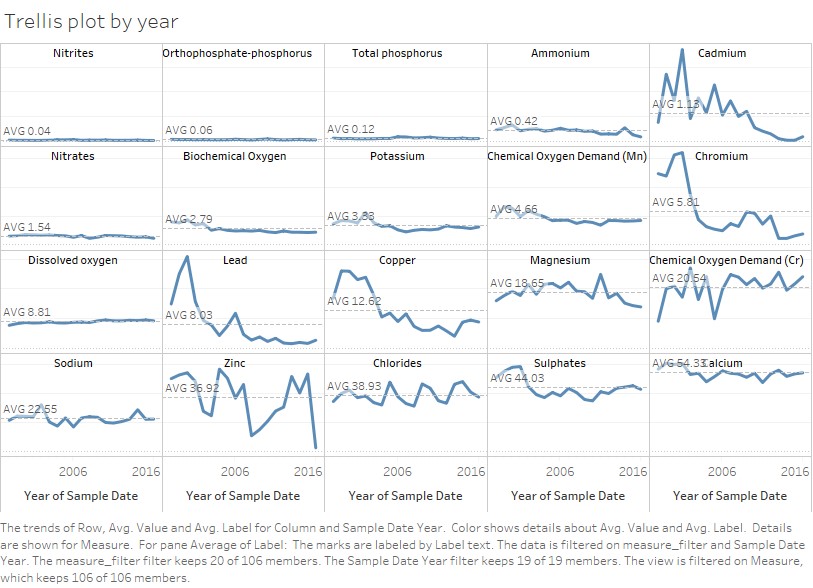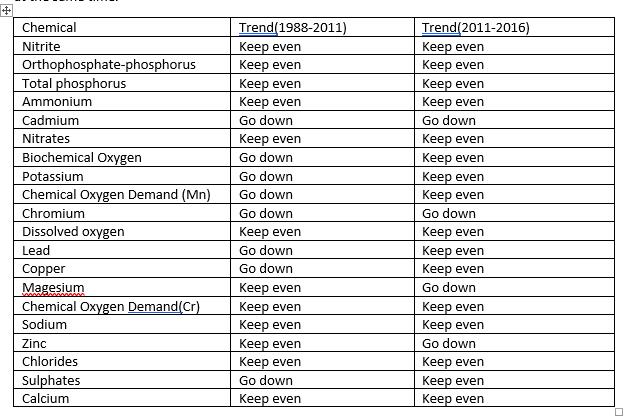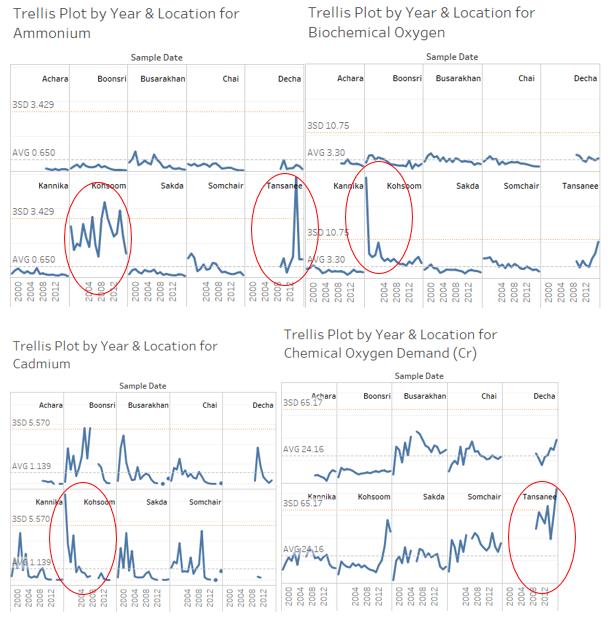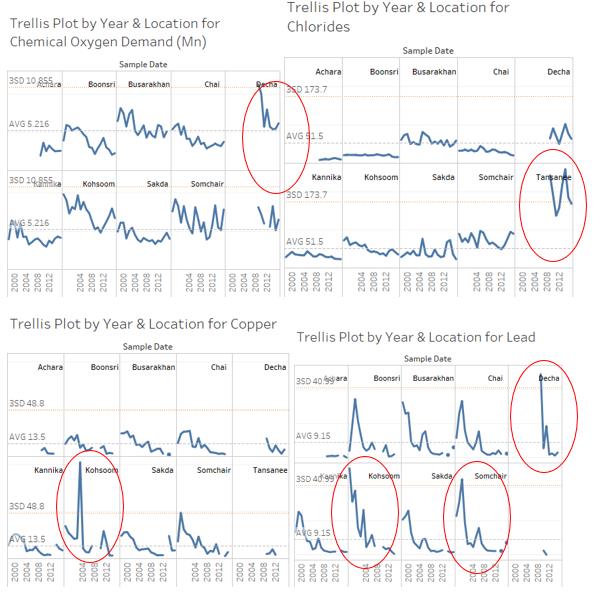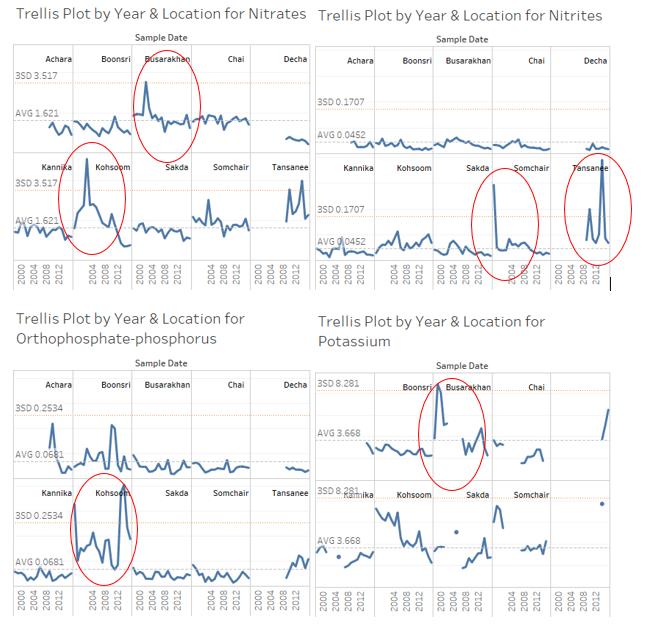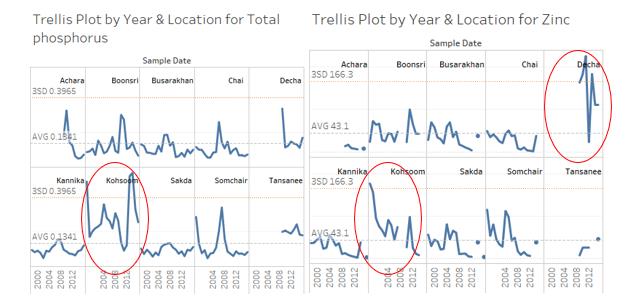Difference between revisions of "Answer1"
| (6 intermediate revisions by the same user not shown) | |||
| Line 20: | Line 20: | ||
===Do you see any trends of possible interest in this investigation?=== | ===Do you see any trends of possible interest in this investigation?=== | ||
[[image:ppp4.jpg]] | [[image:ppp4.jpg]] | ||
| + | |||
According to above table, the Cadmium, Chromium, Lead, Copper, Magnesium, Zinc have more change on the trend. | According to above table, the Cadmium, Chromium, Lead, Copper, Magnesium, Zinc have more change on the trend. | ||
| + | |||
==Question 2== | ==Question 2== | ||
[[image:ppp2.jpg]] | [[image:ppp2.jpg]] | ||
[[image:ppp3.jpg]] | [[image:ppp3.jpg]] | ||
| + | [[image:ppp5.jpg]] | ||
| + | [[image:ppp6.jpg]] | ||
===What anomalies do you find in the waterway samples dataset?=== | ===What anomalies do you find in the waterway samples dataset?=== | ||
*(1) Missing values: | *(1) Missing values: | ||
| Line 37: | Line 41: | ||
===How do these affect your analysis of potential problems to the environment?=== | ===How do these affect your analysis of potential problems to the environment?=== | ||
| + | *(1) Missing Value: | ||
| + | It affects the analysis since many chemicals can not be analysed. | ||
| + | *(2) Duplicate data: | ||
| + | The dataset has duplicate record but can use average to solve. | ||
| + | *(3) Outliers: | ||
| + | The outliers may affect analysis when look at the trend, but these also let people focus on. | ||
| + | |||
===Is the Hydrology Department collecting sufficient data to understand the comprehensive situation across the Preserve? === | ===Is the Hydrology Department collecting sufficient data to understand the comprehensive situation across the Preserve? === | ||
| + | From my perspective, the data is not sufficient to understand the situation since it has missing data for many chemicals. | ||
===What changes would you propose to make in the sampling approach to best understand the situation?=== | ===What changes would you propose to make in the sampling approach to best understand the situation?=== | ||
| + | Approach: The data of water quality should be collected near the location of the factory and should be at the down stream, and far from that at upper stream, so it is will clearly to compare the data and see the difference. | ||
==Question 3== | ==Question 3== | ||
===After reviewing the data, do any of your findings cause particular concern for the Pipit or other wildlife?=== | ===After reviewing the data, do any of your findings cause particular concern for the Pipit or other wildlife?=== | ||
| + | Some chemicals near the Kohsoom and Busarakhan are higher than that of other location, if the factory really locates there, it will affect other wildlife. | ||
| + | |||
=== Would you suggest any changes in the sampling strategy to better understand the waterways situation in the Preserve?=== | === Would you suggest any changes in the sampling strategy to better understand the waterways situation in the Preserve?=== | ||
| + | Strategy: The data should be automatically collected at the same time, so it will be better to compare and need to include as many chemicals ad possible. | ||
Latest revision as of 12:27, 14 July 2018
Vast Chanllenge 2018 MC2
Like a duck to water
| Data Preparation | Visualization Design | Answer | Application | Assignments | |
Contents
- 1 Question 1
- 2 Question 2
- 2.1 What anomalies do you find in the waterway samples dataset?
- 2.2 How do these affect your analysis of potential problems to the environment?
- 2.3 Is the Hydrology Department collecting sufficient data to understand the comprehensive situation across the Preserve?
- 2.4 What changes would you propose to make in the sampling approach to best understand the situation?
- 3 Question 3
Question 1
Characterize the past and most recent situation with respect to chemical contamination in the Boonsong Lekagul waterways.
From the trellis plot by year, Cadmium, Chromium, Lead, Copper, Zinc and Chemical Oxygen Demand (Cr) show relative more fluctuation during 1999-2016 and the rest of the chemicals keep more even at the same time.
Do you see any trends of possible interest in this investigation?
According to above table, the Cadmium, Chromium, Lead, Copper, Magnesium, Zinc have more change on the trend.
Question 2
What anomalies do you find in the waterway samples dataset?
- (1) Missing values:
The data is not complete because many chemicals have too many missing values and can not be used to analyze and lose completeness of time.
- (2) Duplicate values:
The dataset has duplicate record for the same location, same sample date and same chemicals.
- (3) Outliers:
The value of zinc at Decha are high at 2009 and that of lead are high during 2009-2015, but the values of other chemicals seem normal. The value of Nitrite of Tansanee at 2010 and 2014 are higher than that of other location.
Kohsoom has many outliers than other location.From this plot, it is clear that value of chemicals at Kohsoom is always higher other that of location on the same stream. And the value of Busarakhan, Chai which are on the downstream of Kohsoom are also relatively higher. It can be assumed that the source of water pollution may locate near Kohsoom and Busarakhan, then the pollution goes down the stream and influences Chai.
How do these affect your analysis of potential problems to the environment?
- (1) Missing Value:
It affects the analysis since many chemicals can not be analysed.
- (2) Duplicate data:
The dataset has duplicate record but can use average to solve.
- (3) Outliers:
The outliers may affect analysis when look at the trend, but these also let people focus on.
Is the Hydrology Department collecting sufficient data to understand the comprehensive situation across the Preserve?
From my perspective, the data is not sufficient to understand the situation since it has missing data for many chemicals.
What changes would you propose to make in the sampling approach to best understand the situation?
Approach: The data of water quality should be collected near the location of the factory and should be at the down stream, and far from that at upper stream, so it is will clearly to compare the data and see the difference.
Question 3
After reviewing the data, do any of your findings cause particular concern for the Pipit or other wildlife?
Some chemicals near the Kohsoom and Busarakhan are higher than that of other location, if the factory really locates there, it will affect other wildlife.
Would you suggest any changes in the sampling strategy to better understand the waterways situation in the Preserve?
Strategy: The data should be automatically collected at the same time, so it will be better to compare and need to include as many chemicals ad possible.
